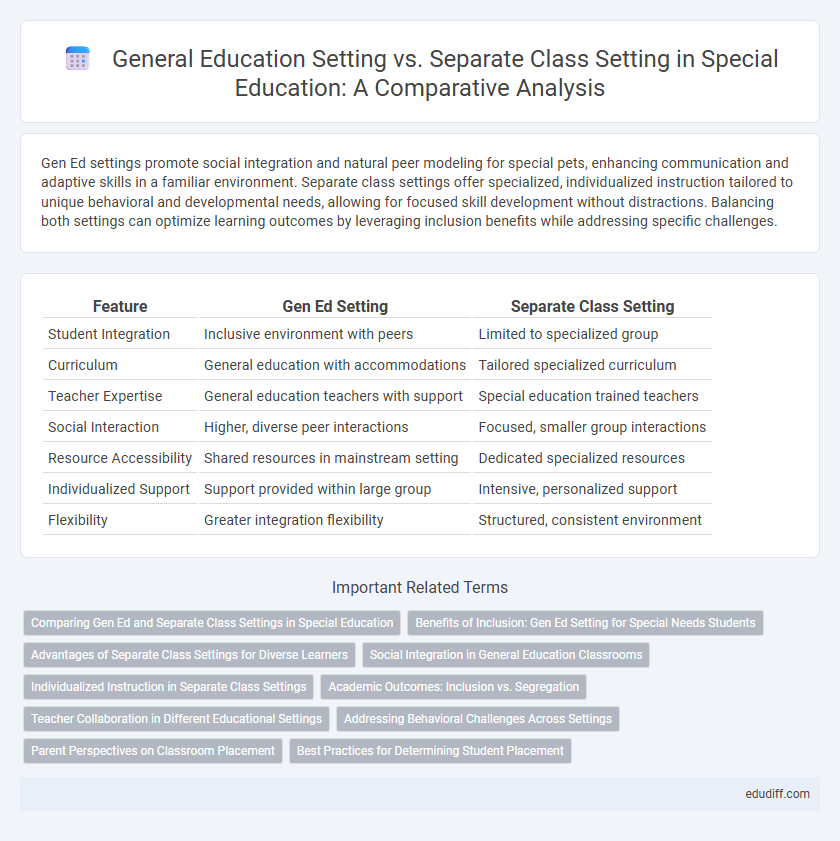Gen Ed settings promote social integration and natural peer modeling for special pets, enhancing communication and adaptive skills in a familiar environment. Separate class settings offer specialized, individualized instruction tailored to unique behavioral and developmental needs, allowing for focused skill development without distractions. Balancing both settings can optimize learning outcomes by leveraging inclusion benefits while addressing specific challenges.
Table of Comparison
| Feature | Gen Ed Setting | Separate Class Setting |
|---|---|---|
| Student Integration | Inclusive environment with peers | Limited to specialized group |
| Curriculum | General education with accommodations | Tailored specialized curriculum |
| Teacher Expertise | General education teachers with support | Special education trained teachers |
| Social Interaction | Higher, diverse peer interactions | Focused, smaller group interactions |
| Resource Accessibility | Shared resources in mainstream setting | Dedicated specialized resources |
| Individualized Support | Support provided within large group | Intensive, personalized support |
| Flexibility | Greater integration flexibility | Structured, consistent environment |
Comparing Gen Ed and Separate Class Settings in Special Education
General education settings promote inclusive learning by integrating students with special needs alongside their peers, enhancing social skills and exposure to a diverse curriculum. Separate class settings provide specialized instruction tailored to individual disabilities, offering targeted support and accommodations that general education environments may lack. Studies indicate that combining both approaches through a continuum of placements optimizes educational outcomes by balancing accessibility and specialized intervention.
Benefits of Inclusion: Gen Ed Setting for Special Needs Students
General education settings promote social interaction and peer modeling for special needs students, enhancing communication and social skills development. Access to the general curriculum alongside typically developing peers supports higher academic expectations and improved learning outcomes. Inclusion fosters a sense of belonging and reduces stigma, contributing to better emotional well-being and self-esteem for special needs learners.
Advantages of Separate Class Settings for Diverse Learners
Separate class settings offer tailored instructional strategies that address the unique learning needs of diverse students, promoting better academic outcomes and social development. These environments provide specialized resources and smaller teacher-to-student ratios, enhancing personalized support and engagement. Focused peer interactions in separate classes foster a supportive community, boosting confidence and reducing feelings of isolation among learners with diverse abilities.
Social Integration in General Education Classrooms
Social integration in general education classrooms enhances the development of social skills and peer relationships for students with special needs. Gen Ed settings promote inclusive interactions, fostering a sense of belonging and reducing stigma compared to separate class settings. Research indicates that inclusive environments contribute to improved academic performance and social competence for students with disabilities.
Individualized Instruction in Separate Class Settings
Separate class settings provide individualized instruction tailored to each student's unique learning needs, allowing for specialized teaching strategies and customized curriculum pacing. This approach enhances skill development by addressing specific challenges and strengths, fostering a supportive environment for academic growth. Individualized instruction in separate classes significantly improves student engagement and achievement compared to generalized strategies used in inclusive Gen Ed settings.
Academic Outcomes: Inclusion vs. Segregation
Academic outcomes in general education (Gen Ed) settings demonstrate higher achievement and improved social skills for students with special needs due to inclusive teaching practices and diversified peer interactions. In contrast, separate class settings often result in limited academic growth and fewer opportunities for social integration, as segregation restricts exposure to grade-level curriculum and mainstream peers. Research indicates inclusion promotes equity and access, leading to enhanced learning outcomes compared to segregated environments.
Teacher Collaboration in Different Educational Settings
Teacher collaboration varies significantly between General Education (Gen Ed) and Separate Class settings, influencing instructional strategies and student outcomes. In Gen Ed settings, collaboration emphasizes co-planning and co-teaching within diverse classrooms, fostering inclusive practices. Separate Class settings require specialized coordination among educators focused on tailored interventions and individualized learning plans for students with unique needs.
Addressing Behavioral Challenges Across Settings
Gen Ed settings integrate behavioral support within inclusive classrooms, promoting social skills through peer interaction and consistent routines, which enhances generalization of positive behaviors. Separate class settings allow for specialized, intensive interventions tailored to individual behavioral needs, often using structured environments and individualized behavior plans to address challenges more directly. Combining strategies from both settings can optimize behavior outcomes by balancing skill generalization and targeted support.
Parent Perspectives on Classroom Placement
Parents of children with special needs often weigh the benefits of General Education (Gen Ed) settings versus Separate Class settings based on inclusion, social interaction, and academic support. Many parents value Gen Ed settings for promoting peer integration and a sense of belonging, while others prioritize Separate Class settings for specialized attention and tailored instructional strategies. Research indicates that parental satisfaction correlates strongly with clear communication from educators about individualized goals and classroom dynamics.
Best Practices for Determining Student Placement
Effective student placement involves careful evaluation of individual learning needs, strengths, and challenges through multidisciplinary assessments. Collaboration among educators, specialists, and families ensures decisions align with academic goals and social inclusion preferences. Utilizing data-driven tools and ongoing progress monitoring promotes appropriate placement within either general education settings or separate class environments to maximize student success.
Gen Ed Setting vs Separate Class Setting Infographic

 edudiff.com
edudiff.com